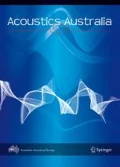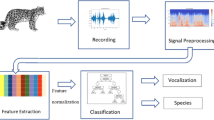Abstract
To expand the spatial and temporal scales of passive acoustic monitoring of animals, automatically detecting target sounds among noises with similar acoustic properties is essential but challenging. In particular, the classification of tonal vocalisations and tonal noise remains a universal problem in bioacoustics research. The vocalisations of dugong, which is an endangered marine mammal that inhabits coastal seas, need to be monitored to enhance our understanding of its habitat use. However, detecting dugong tonal vocalisations is difficult due to the presence of tonal noise in the same frequency band. In this study, a classification method was developed for these signals to handle large acoustic data by reducing the labour required for manual inspection. Mel-frequency cepstral coefficients (MFCC) were extracted to characterise background sounds along with a few parameters of the signal contour, and a support vector machine was trained for binary classification. The classifier achieved an 84.4% recall and a 93.5% precision on the testing dataset even in a noisy shallow marine environment. This methodology enables the effective classification of dugong calls and similar tonal noises by combining contour and MFCC features and can extend the spatial and temporal scale of acoustic monitoring of the endangered dugong. This technique is potentially applicable to the monitoring of other endangered marine mammals that produce tonal vocalisations.






Similar content being viewed by others
References
Zwart, M.C., Baker, A., McGowan, P.J.K., Whittingham, M.J.: The use of automated bioacoustic recorders to replace human wildlife surveys: an example using nightjars. PLoS ONE 9, e102770 (2014). https://doi.org/10.1371/journal.pone.0102770
Wrege, P.H., Rowland, E.D., Keen, S., Shiu, Y.: Acoustic monitoring for conservation in tropical forests: examples from forest elephants. Methods Ecol. Evol. 8, 1292–1301 (2017). https://doi.org/10.1111/2041-210X.12730
Marques, T.A., Thomas, L., Martin, S.W., Mellinger, D.K., Ward, J.A., Moretti, D.J., Harris, D., Tyack, P.L.: Estimating animal population density using passive acoustics. Biol. Rev. Camb. Philos. Soc. 88, 287–309 (2013). https://doi.org/10.1111/brv.12001
Mellinger, D., Barlow, J.: Future directions for acoustic marine mammal surveys: Stock assessment and habitat use. Report of a workshop held in la Jolla, CA, 20–22 November (2003)
Mellinger, D., Stafford, K., Moore, S., Dziak, R., Matsumoto, H.: An overview of fixed passive acoustic observation methods for cetaceans. Oceanography 20, 36–45 (2007). https://doi.org/10.5670/oceanog.2007.03
Baumgartner, M.F., Mussoline, S.E.: A generalized baleen whale call detection and classification system. J. Acoust. Soc. Am. 129, 2889–2902 (2011). https://doi.org/10.1121/1.3562166
Bittle, M., Duncan, A.: A review of current marine mammal detection and classification algorithms for use in automated passive acoustic monitoring. Proc. Acoust. 8, 1–8 (2013)
Lin, T.H., Chou, L.S., Akamatsu, T., Chan, H.C., Chen, C.F.: An automatic detection algorithm for extracting the representative frequency of cetacean tonal sounds. J. Acoust. Soc. Am. 134, 2477–2485 (2013). https://doi.org/10.1121/1.4816572
Niezrecki, C., Phillips, R., Meyer, M., Beusse, D.O.: Acoustic detection of manatee vocalizations. J. Acoust. Soc. Am. 114, 1640–1647 (2003). https://doi.org/10.1121/1.1598196
Yan, Z., Niezrecki, C., Beusse, D.O.: Background noise cancellation for improved acoustic detection of manatee vocalizations. J. Acoust. Soc. Am. 117, 3566–3573 (2005). https://doi.org/10.1121/1.1904385
Marsh, H., United Nations Environment Programme eds: Dugong: Status Report and Action PLANS for Countries and Territories. United Nations Environment Programme, Nairobi (2002)
Marsh, H., Sobtzick, S.: Dugong dugon (amended version of 2015 assessment): the IUCN Red List of Threatened Species 2019: e.T6909A160756767 (2019). https://doi.org/10.2305/IUCN.UK.2015-4.RLTS.T6909A160756767.en
Anderson, P.K., Barclay, R.M.R.: Acoustic signals of solitary dugongs: physical characteristics and behavioral correlates. J. Mammal. 76, 1226–1237 (1995). https://doi.org/10.2307/1382616
Ichikawa, K., Tsutsumi, C., Arai, N., Akamatsu, T., Shinke, T., Hara, T., Adulyanukosol, K.: Dugong (Dugong dugon) vocalization patterns recorded by automatic underwater sound monitoring systems. J. Acoust. Soc. Am. 119, 3726–3733 (2006). https://doi.org/10.1121/1.2201468
Ichikawa, K., Akamatsu, T., Shinke, T., Sasamori, K., Miyauchi, Y., Abe, Y., Adulyanukosol, K., Arai, N.: Detection probability of vocalizing dugongs during playback of conspecific calls. J. Acoust. Soc. Am. 126, 1954–1959 (2009). https://doi.org/10.1121/1.3203805
Ichikawa, K., Akamatsu, T., Shinke, T., Arai, N., Adulyanukosol, K.: Clumped distribution of vocalising dugongs (Dugong dugon) monitored by passive acoustic and visual observations in Thai waters. Proc. Acoust. 130–133 (2012)
Monnahan, C.C., Branch, T.A., Stafford, K.M., Ivashchenko, Y.V., Oleson, E.M.: Estimating historical eastern North Pacific blue whale catches using spatial calling patterns. PLoS ONE 9, e98974 (2014). https://doi.org/10.1371/journal.pone.0098974
Watkins, W.A., Daher, M.A., Reppucci, G.M., George, J.E., Martin, D., DiMarzio, N.A., Gannon, D.P.: Seasonality and distribution of whale calls in the North Pacific. Oceanography 13, 62–67 (2000)
Tanaka, K., Ichikawa, K., Nishizawa, H., Kittiwattanawong, K., Arai, N., Mitamura, H.: Differences in vocalisation patterns of dugongs between fine-scale habitats around Talibong Island, Thailand. Acoust. Aust. 45, 243–251 (2017). https://doi.org/10.1007/s40857-017-0094-7
Louise Chilvers, B., Delean, S., Gales, N.J., Holley, D.K., Lawler, I.R., Marsh, H., Preen, A.R.: Diving behaviour of dugongs, Dugong dugon. J. Exp. Mar. Biol. Ecol. 304, 203–224 (2004). https://doi.org/10.1016/j.jembe.2003.12.010
Mellinger, D.K., Martin, S.W., Morrissey, R.P., Thomas, L., Yosco, J.J.: A method for detecting whistles, moans, and other frequency contour sounds. J. Acoust. Soc. Am. 129, 4055–4061 (2011). https://doi.org/10.1121/1.3531926
Zaugg, S., van der Schaar, M., Houégnigan, L., Gervaise, C., André, M.: Real-time acoustic classification of sperm whale clicks and shipping impulses from deep-sea observatories. Appl. Acoust. 71, 1011–1019 (2010). https://doi.org/10.1016/j.apacoust.2010.05.005
Erbe, C., King, A.R.: Automatic detection of marine mammals using information entropy. J. Acoust. Soc. Am. 124, 2833–2840 (2008). https://doi.org/10.1121/1.2982368
Hines, E.M., Adulyanukosol, K., Duffus, D.A.: Dugong (Dugong dugon) abundance along the Andaman coast of Thailand. Mar. Mamm. Sci. 21, 536–549 (2005). https://doi.org/10.1111/j.1748-7692.2005.tb01247.x
Adulyanukosol, K., Poovachiranon, S.: Dugong (Dugong dugon) and seagrass in Thailand: Present status and future challenges. In: Proceedings of the 3rd International Symposium on SEASTAR2000 and Asian Bio-logging Science (The 7th SEASTAR2000 workshop), pp. 41–50 (2006)
Hishimoto, Y., Ichikawa, K., Akamatsu, T., Arai, N.: The acoustical characteristics of dugong calls and the behavioral correlation observed in Toba aquarium. In: Proceedings of the 2nd International Symposium on SEASTAR2000 and Asian Bio-logging Science (The 6th SEASTAR2000 Workshop), pp. 25–28 (2005)
Okumura, N., Ichikawa, K., Akamatsu, T., Arai, N., Shinke, T., Adulyanukosol, K.: Pattern analyses on the vocal structure of calls and geographic variations among three areas. In: Proceedings of the 3rd International Symposium on SEASTAR2000 and Asian Bio-logging Science (The 7th SEASTAR2000 workshop), pp. 63–67 (2006)
Ichikawa, K., Akamatsu, T., Shinke, T., Adulyanukosol, K., Arai, N.: Callback response of dugongs to conspecific chirp playbacks. J. Acoust. Soc. Am. 129, 3623–3629 (2011). https://doi.org/10.1121/1.3586791
Parsons, M.J.G., Holley, D., McCauley, R.D.: Source levels of dugong (Dugong dugon) vocalizations recorded in shark Bay. J. Acoust. Soc. Am. 134, 2582–2588 (2013). https://doi.org/10.1121/1.4816583
Japan Ministry of Defense: Schwab (H25) Suiikikentou 2, 3 (2015). (in Japanese)
Koops, H.V., van Balen, J., Wiering, F.: Automatic segmentation and deep learning of bird sounds. In: Experimental IR Meets Multilinguality, Multimodality, and Interaction, vol. 9283, pp. 261–267. Springer, Cham (2015)
Mielke, A., Zuberbühler, K.: A method for automated individual, species and call type recognition in free-ranging animals. Anim. Behav. 86, 475–482 (2013). https://doi.org/10.1016/j.anbehav.2013.04.017
Gaikwad, S., Chitre, A.V., Dandawate, Y.H.: Classification of Indian classical instruments using spectral and principal component analysis based cepstrum features. In: International Conference on Electronic Systems, Signal Processing and Computing Technologies, pp. 276–279. IEEE, Nagpur, India (2014)
Tzanetakis, G., Cook, P.: Musical genre classification of audio signals. IEEE Trans. Speech Audio Process. 10, 293–302 (2002). https://doi.org/10.1109/TSA.2002.800560
Yücesoy, E., Nabiyev, V.V.: Gender identification of a speaker using MFCC and GMM. In: 8th International Conference on Electrical and Electronics Engineering (ELECO), pp. 626–629. IEEE (2013)
Chou, C.-H., Ko, H.-Y.: Automatic birdsong recognition with MFCC based syllable feature extraction. In: Hsu, C.-H., Yang, L.T., Ma, J., Zhu, C. (eds.) Ubiquitous intelligence and computing, pp. 185–196. Springer, Berlin (2011)
Mirzaei, G., Majid, M.W., Ross, J., Jamali, M.M., Gorsevski, P.V., Frizado, J.P., Bingman, V.P.: The BIO-acoustic feature extraction and classification of bat echolocation calls. In: IEEE International Conference on Electro/Information Technology, pp. 1–4. IEEE, Indianapolis (2012)
Cortes, C., Vapnik, V.: Support-vector networks. Mach. Learn. 20, 273–297 (1995). https://doi.org/10.1007/BF00994018
Jarvis, J., Jackson, W., Smotherman, M.: Groups of bats improve sonar efficiency through mutual suppression of pulse emissions. Front. Physiol. 4, 140 (2013). https://doi.org/10.3389/fphys.2013.00140
Roch, M.A., Soldevilla, M.S., Burtenshaw, J.C., Henderson, E.E., Hildebrand, J.A.: Gaussian mixture model classification of odontocetes in the Southern California Bight and the Gulf of California. J. Acoust. Soc. Am. 121, 1737–1748 (2007). https://doi.org/10.1121/1.2400663
Yovel, Y., Au, W.W.L.: How can dolphins recognize fish according to their echoes? A statistical analysis of fish echoes. PLoS ONE 5, e14054 (2010). https://doi.org/10.1371/journal.pone.0014054
Risch, D., Clark, C., Dugan, P., Popescu, M., Siebert, U., Van Parijs, S.: Minke whale acoustic behavior and multi-year seasonal and diel vocalization patterns in Massachusetts Bay, USA. Mar. Ecol. Prog. Ser. 489, 279–295 (2013). https://doi.org/10.3354/meps10426
Zaugg, S., van der Schaar, M., Houégnigan, L., André, M.: A framework for the automated real-time detection of short tonal sounds from ocean observatories. Appl. Acoust. 73, 281–290 (2012). https://doi.org/10.1016/j.apacoust.2011.09.009
Radford, C.A., Stanley, J.A., Jeffs, A.G.: Adjacent coral reef habitats produce different underwater sound signatures. Mar. Ecol. Prog. Ser. 505, 19–28 (2014). https://doi.org/10.3354/meps10782
Matsuo, Y., Ichikawa, K., Ando-Mizobata, N., Arai, N.: Cyclic change of dugong’s vocal behavior. J. Adv. Mar. Sci. Technol. Soc. 19, 1–4 (2013)
Khogkhao, C., Hayashizaki, K., Tuntiprapas, P., Prathep, A.: Changes in seagrass communities along the runoff gradient of the Trang river, Thailand. ScienceAsia 43, 339–346 (2017). https://doi.org/10.2306/scienceasia1513-1874.2017.43.339
Deecke, V.B., Ford, J.K.B., Spong, P.: Quantifying complex patterns of bioacoustic variation: Use of a neural network to compare killer whale (Orcinus orca) dialects. J. Acoust. Soc. Am. 105, 2499–2507 (1999). https://doi.org/10.1121/1.426853
Acknowledgements
This study was supported by Japan Society for the Promotion of Science (JSPS) KAKENHI JP25871062, JP17H01678, and JP19J14891. The authors appreciate and thank the residents of Talibong Island in Thailand, AquaSound Inc., IDEA Consultants Inc., the members of the Biosphere Informatics Laboratory, and the members of the Fisheries and Environmental Oceanography Laboratory at Kyoto University for their generous support and cooperation. We would like to thank Editage (www.editage.com) for English language editing.
Funding
This study was supported by Japan Society for the Promotion of Science (JSPS) KAKENHI JP25871062, JP17H01678, and JP19J14891.
Author information
Authors and Affiliations
Contributions
All authors contributed to the study conception and design. Kongkiat Kittiwattanawong supervised all fieldwork. Kotaro Ichikawa, Kongkiat Kittiwattanawong, and Nobuaki Arai collected the acoustic data in the field. Data analysis was performed by Kotaro Tanaka, Kotaro Ichikawa, Nobuaki Arai, and Hiromichi Mitamura. The first draft of the manuscript was written by Kotaro Tanaka, and all authors commented on previous versions of the manuscript. All authors read and approved the final manuscript.
Corresponding author
Ethics declarations
Conflict of interest
The authors declare that they have no conflict of interest.
Additional information
Publisher’s Note
Springer Nature remains neutral with regard to jurisdictional claims in published maps and institutional affiliations.
Rights and permissions
About this article
Cite this article
Tanaka, K., Ichikawa, K., Kittiwattanawong, K. et al. Automated Classification of Dugong Calls and Tonal Noise by Combining Contour and MFCC Features. Acoust Aust 49, 385–394 (2021). https://doi.org/10.1007/s40857-021-00234-5
Received:
Accepted:
Published:
Issue Date:
DOI: https://doi.org/10.1007/s40857-021-00234-5




